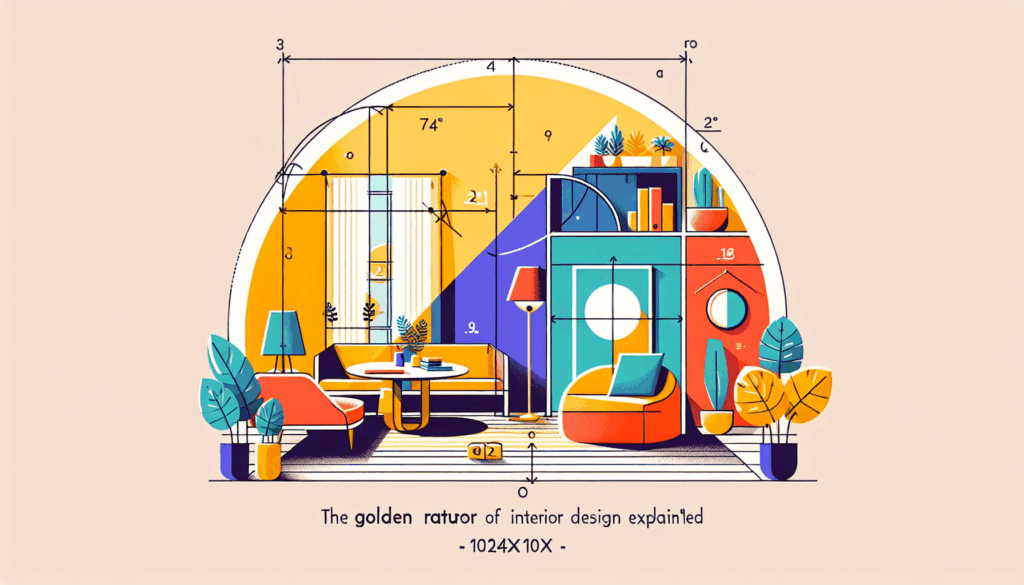When it comes to creating a harmonious and aesthetically pleasing interior space, the Golden Ratio is a concept that has stood the test of time. It’s a mathematical ratio, approximately 1.618, that has been used in art, architecture, and design for centuries. This blog post will delve into the Golden Ratio, how it applies to interior design, and how you can incorporate it into your home for a more balanced and beautiful environment.

Understanding the Golden Ratio
The Golden Ratio, often denoted by the Greek letter phi (Φ), represents an ideal proportion that humans find naturally pleasing. It appears in nature, art, architecture, and even in the human body. In simple terms, if you have a rectangle where the longer side is in a 1:1.618 ratio to the shorter side, you have a Golden Rectangle. This proportion is thought to create a sense of balance and beauty.
In interior design, the Golden Ratio can be applied through various elements including layouts, furniture arrangement, colors, and even decor pieces. By adhering to this ratio, designers aim to create spaces that feel naturally balanced and inviting.
How the Golden Ratio Works in Interior Design
1. Layout and Space Planning
One of the most significant applications of the Golden Ratio in interior design is in layout and space planning. When designing a room, consider the overall dimensions and proportions. For instance, if you have a room that is 12 feet wide, the ideal length based on the Golden Ratio would be approximately 19.6 feet (12 feet x 1.618).
In practical terms, this means that when arranging furniture, you might position larger pieces in a way that reflects this ratio. If you have a large sofa, for example, place it in a way that allows for a balance with smaller accent chairs or tables, creating a visually appealing arrangement that follows the Golden Ratio.
2. Furniture Arrangement
The Golden Ratio can also influence how you arrange furniture within a space. For a living room, consider the arrangement of furniture in relation to the overall dimensions of the room. If your sofa occupies a length of 6 feet, your coffee table could ideally be around 3.7 feet, adhering to the ratio of 1:1.618.
This not only ensures that the pieces work well together visually but also that they create a comfortable and functional space for movement and interaction.
3. Color Schemes
Color can greatly affect the perception of space and harmony within a room. When selecting a color palette, the Golden Ratio can help guide you in creating a balanced environment. For example, if you choose a dominant color that occupies 60% of the room (like a wall color), you might select a secondary color that makes up 30% (like upholstery), and an accent color that comprises 10% (like throw pillows or artwork).
This proportion not only creates visual interest but also ensures that no single color overwhelms the space, promoting a sense of calm and balance.
4. Artwork and Decor Placement
When it comes to artwork and decor, the Golden Ratio can guide the placement and sizing of pieces. If you’re hanging artwork on a wall, consider the dimensions of the wall and how the artwork can be arranged to follow the Golden Ratio.
For instance, if you have a wall that is 8 feet wide, a piece of art that is approximately 5 feet wide (8 feet x 0.618) would be ideally sized to create a harmonious focal point. Additionally, when arranging multiple pieces, consider spacing them according to the Golden Ratio to create a cohesive gallery wall.
5. Architectural Elements
Architectural features in a home, such as windows, doors, and moldings, can also benefit from the Golden Ratio. Consider the proportions of windows in relation to the walls or the height of a door in relation to the ceiling. These elements should reflect the harmonious proportions that the Golden Ratio is known for.
Practical Tips for Incorporating the Golden Ratio
– Measure and Calculate: Before starting your interior design project, measure the spaces you’re working with. Use the Golden Ratio to calculate the ideal dimensions for furniture, decor, and layout.
– Choose Focal Points: Identify focal points in your room and apply the Golden Ratio to their placement and size. This could be a large piece of furniture, artwork, or an architectural feature.
– Experiment with Proportions: Don’t be afraid to experiment. If something feels off, reassess the proportions and adjust according to the Golden Ratio until you achieve that feeling of balance.
– Combine With Other Principles: While the Golden Ratio is a powerful tool, it’s essential to combine it with other design principles such as symmetry, contrast, and harmony for a well-rounded approach.
Conclusion
The Golden Ratio is more than just a mathematical concept; it’s a valuable tool in the world of interior design that can help create spaces that are aesthetically pleasing and functionally effective. By understanding and applying the Golden Ratio in your home, you can achieve a level of balance and beauty that resonates on both a visual and emotional level.
Whether you’re redecorating a single room or embarking on a complete home renovation, consider the Golden Ratio as a guiding principle. With a little planning and creativity, you can transform your space into a harmonious sanctuary that reflects both elegance and comfort.
AI-Assisted Content Disclaimer
This article was created with AI assistance and reviewed by a human for accuracy and clarity.






Leave a Reply